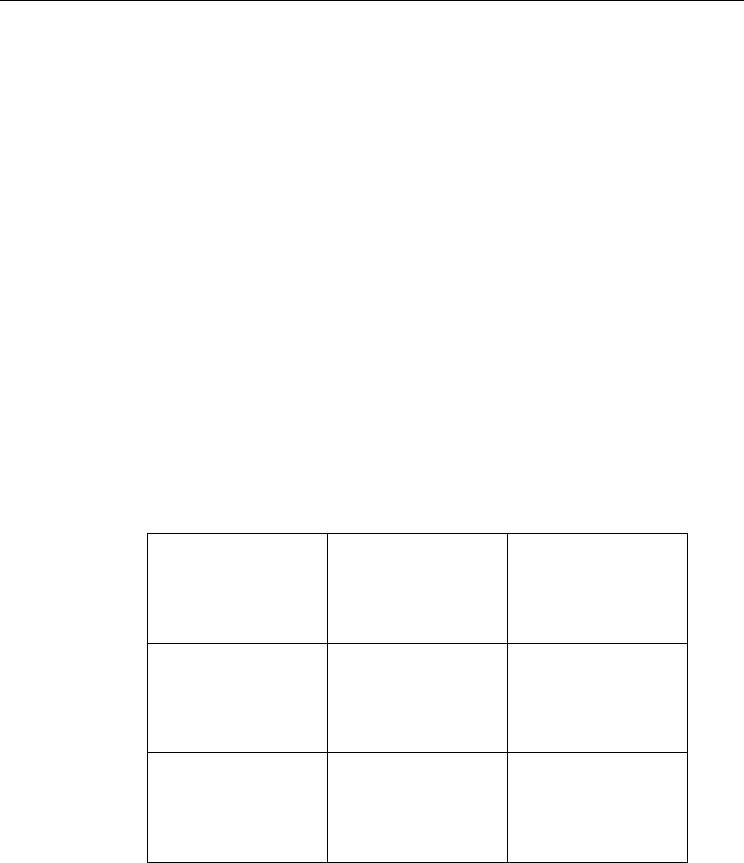I. Ramos Arreguin (ed.) Automation and Robotics
Подождите немного. Документ загружается.


Fuzzy Knowledge Representation Using Probability Measures of Fuzzy Events
333
A set of probability values
)},({
ji
BAP
×
of fuzzy events (fuzzy relations)
ji
BA × , i=1,…,I,
j=1,…,J can be calculated using the basic definition (4), as follows
∑
×∈
×
=×
VUvu
j
B
i
Aji
vuvupBAP
),(
),(),()(
μ
(17)
where
]1,0[),( ∈vup is a joint probability function.
If the set of probabilities of fuzzy events
)}({
ji
BAP
×
fulfils the relationship
∑∑
==
=×
I
i
J
j
ji
BAP
11
1)(
(18)
then, it states a joint probability distribution P(X,Y) of the linguistic vector variables (X,Y).
The marginal probability distributions
IiAPXP
i
,...,1)},({)(
=
=
, and )}({)(
j
BPYP
=
, j=1,…,J
can be calculated for particular linguistic variables, as follows:
∑
=
×=
J
j
jii
BAPAP
1
)()(
(19)
∑
=
×=
I
i
jij
BAPBP
1
)()( (20)
The marginal distributions P(X) and P(Y) defined above are normalized:
1)(
1
=
∑
=
I
i
i
AP , 1)(
1
=
∑
=
J
j
j
BP (21)
Conditional probability distributions of particular linguistic variables can be derived from
the joint probability distribution P(X,Y) given by (17) and a marginal probability
distributions (19) or (20). The conditional probability distribution P(Y/X) of the linguistic
variable Y, under the condition that X takes fuzzy values
IiA
i
,...,1,
=
, is a set of probability
values
)}/({)/(
ij
ABPXYP = ,j=1,…,J; i=const, calculated as follows:
)(/)()/(
ijiij
APBAPABP
×
=
, j=1,…,J; i=const. (22)
Taking into account the normalization of probability distributions (see (18) and (21)), the
total probability of the result
j
B can be calculated, similarly to Bayes’ formula, and
assuming, that the conditional probabilities
)/(
ij
ABP , i=1,…,I, calculated under the
condition of the reasons
i
A are known (Walaszek-Babiszewska, 2008):
∑
=
=
I
i
iijj
APABPBP
1
)()/()( . (23)
Let us note, that fuzzy sets
IiA
i
,...,1,
=
are not disjoint in U.

Automation and Robotics
334
3. Exemplary linguistic and probabilistic modelling
3.1 Particle characteristics as results of measurements
In chemical and biochemical research, in many industrial processes such as mineral
preparation processes or in numerous food processes, the material to be prepared consists of
a population of different types of particles.
There are basic characteristics of material utilised by process engineers and automation
engineers:
• a characteristic of the size composition presenting portions of particles belonging to
different size fractions,
• a densimetric characteristic presenting portions of particles belonging to different
density fractions,
• a characteristic of tested chemical components.
The two first characteristics are often considered as an empirical probability distribution of a
two-dimensional random variable: volume x and density y of particles
JjIiNNbyaxPyxp
ijjiij
,...,2,1;,...,2,1,/),(),( ===∈∈=
(24)
where a
i,
i=1,…, I are disjoint intervals of the particle size (size classes) in a domain X, and b
j
,
j=1,…,J are disjoint intervals of the particle density (density fractions) in a domain Y , N
ij
is a
number of that particles in the parent population, whose volume belongs to i-th interval a
i
and the density belongs to j-th interval b
j
, N is a total number of particles in the population,
and
∑∑
==
=
I
i
J
j
ij
NN
11
.
In engineering practice a different measure of the probability is being more often applying,
the quotient of the respective masses:
MMyx
ijij
/),(
=
π
i=1,2,..., I; j =1,2,...,J; (25)
where M
ij
is a mass of that particles in the parent population, whose volume belongs to i-th
interval a
i
and the density belongs to j-th interval b
j
, and
ijjmimij
NyxM
,,
=
, where
im
x
,
,
jm
y
,
are mean values of particle volume and density in the intervals a
i
and b
j
, respectively;
M is a total mass of the population,
NyxM
mm
=
, where x
m
, y
m
are mean values of volume
and density of particles in the population, and
∑∑
==
=
I
i
J
j
ij
MM
11
.
There is a relation between two expressions of empirical probabilities (Walaszek-
Babiszewska, 2004):
ijijij
pa
=
π
, i=1,2,..., I; j =1,2,...,J; (26)
where:
mm
jmim
ij
yx
yx
a
,,
=
. (27)
Table 1 presents the values of an empirical joint probability distribution p(x
i
,y
j
)=p
ij
,
calculated on the base of measurements (Walaszek-Babiszewska, 2004). Each of the ranges of

Fuzzy Knowledge Representation Using Probability Measures of Fuzzy Events
335
volume and density of particles has been divided into 4 intervals. The smallest value of
indexes i,j concerns to the smallest value of density and volume:
.;
43214321
yyyyxxxx
<
<
<
<
<
<
The marginal probabilities p
i.
(x) and p.
j
( y) are also given in Table 1.
Density
fraction
number
Probability p
ij
(x, y)
Size class number
j
i=1 i=2 i=3 i=4
Marginal
probability
p
.j
(y)
1 0.6290 0.0304 0.0074 0.0020 0.6688
2 0.1338 0.0044 0.0011 0.0003 0.1396
3 0.0534 0.0050 0.0010 0.0002 0.0596
4 0.1198 0.0092 0.0025 0.0005 0.1320
Marginal
probability
p
i.
(x)
0.9360
0.0490
0.0120
0.0030
1
.
.
=
=
∑
∑
j
j
i
i
p
p
Table 1. The empirical joint probability distribution p
ij
(x,y) and marginal probability
distributions p
.j
(y), p
i.
(x) of particle features
3.2 Linguistic characteristics of particles
Perception-based information of human experts, expressing in natural language a quantity-
quality characteristic of particles features, can be verified on the base of linguistic and
probabilistic modelling presented above.
Let us assume two linguistic variables considered above:
x
name
: ‘volume of particles’ and the set of linguistic values L(X)={small(A
1
), middle(A
2
),
large(A
3
)} with the membership functions determined over the disjoint intervals a
i,
i=1,…, I as
follows:
211
/2.0/1 aaA
+
=
;
322
/8.0/8.0 aaA
+
=
;
433
/1/2.0 aaA
+
=
y
name
: ‘density of particles’ and the set of linguistic values L(Y)={light(B
1
), middle(B
2
), heavy(B
3
)}
with the membership functions determined over the disjoint intervals b
j
, j=1,…, J, as
follows:
211
/5.0/1 bbB +=
;
322
/5.0/5.0 bbB +=
;
433
/1/5.0 bbB +=
For these two linguistic variables and the empirical joint probability distribution given in
Table 1. we can calculate the probability of the simultaneous events, e.g.
P{ (x is small) and (y is light)}
using (16) i (17) as follows:
)()(),(
)()(),()()(),()()(),()(
2
1
2
1
22
1
1
2
1
212
1
1
1
121
1
1
1
1111
bayxp
bayxpbayxpbayxpBAP
BA
BABABA
μμ
μμμμμμ
+++=×

Automation and Robotics
336
=× )(
11
BAP 0.6290⋅1⋅1+0.1338⋅1⋅0.5+0.0304⋅0.2⋅1+0.0044⋅0.2⋅0.5=0.7024
In the similar way we can compute the values of probabilities
)(
ji
BAP
×
, i,j=1,2,3 (Table 2.).
A
1
A
2
A
3
P(B
j
)
B
1
0.7024 0.0324 0.0037 0.7385
B
2
0.0946 0.0046 0.0005 0.0997
B
3
0.1488 0.0118 0.0012 0.1618
P(A
i
)
0.9458 0.0488 0.0054
∑
P(A
i
)=
∑
P(B
j
)=1
Table 2. The probability distributions of linguistic variables (x,y) representing probability of
fuzzy events
)(
ji
BAP
×
and marginal probabilities
Probability distributions of linguistic variables (Table 2.) could be used for the validation of
experts’ opinion:
‘The contents of the light and small particles is very high’;
=× )(
11
BAP 0.7024;
‘The contents of the light fraction is high’; P(B
l
)=0.7385;
‘The contents of large particles is low’; P(A
3
)=0.0054.
The values of probability of fuzzy events calculated according to (16) and (17) depend on a
choice of a t-norm. The problem is important for creating the inference procedure in
knowledge-based systems.
3.3 Quality parameters of particles as a mean value of a fuzzy event
Characteristics of tested chemical components in population of particles are usually called
the quality characteristics. Suppose the quality parameter
),(
jiij
yx
β
β
=
in every elementary
fraction of particles, where
i
x ,
j
y are mean values of particle volume and density in the
intervals a
i
and b
j
, respectively. The mean value of a tested substance in the population of
particles whose features are determined by a fuzzy event e.g. “C: small and light particles"
can be calculated by using the notion of a mean value of fuzzy event, as follows (Walaszek-
Babiszewska, 2004):
∑∑
∑∑
==
==
=
I
i
J
j
jiCij
I
i
J
j
jiCijij
C
yxp
yxp
11
11
),(
),(
μ
μβ
β
(28)
4. Knowledge representation
4.1 General form of a fuzzy model
A fuzzy model represented a MISO system, consisting of the collection of fuzzy rules in a
form ‘IF x is A THEN y is B’ is considered (Yager and Filev, 1995). The propositions x is A in
antecedents and y is B in consequents of rules are based on the partition of the input-output
space, given by experts. The exemplary i-th file rule includes J elementary rules, in a form:

Fuzzy Knowledge Representation Using Probability Measures of Fuzzy Events
337
))(
)(
)(
...(:
/
/
/11
,,22,11
iJJ
ijj
i
ippiiii
wBisyALSO
wBisyALSO
wBisyTHEN
AisxANDAisxANDAisxIFwR
−−−−−−−−−−−−
−−−−−−−−−−−−
(29)
where
),...,(
1 p
T
xxx = is a linguistic vector of system inputs (antecedent variables), y is a
linguistic output variable. The linguistic values (term sets)
)(),(),...,(
1
yLxLxL
p
of the input
and output variables are predefined by process experts. Fuzzy sets
ipi
AA
,,1
,...,
,, i=1,…,I
represent linguistic values of the input vector, and are defined by membership functions
)(),...,(
,
1
,1
p
ip
A
i
A
uu
μ
μ
in the domains
p
UU ,...,
1
, piRU
i
,...,1,
=
⊂ . The linguistic output
(consequent) variable y has the family of fuzzy subsets
j
B with membership functions
)(v
j
B
μ
, j=1,…,J in the numeric space .RV ⊂
The rule weights
i
w and
ij
w
/
i=1,…,I, j=1,…,J represent probabilities of fuzzy events
occurring in the antecedents and consequence of the model
)(
ii
APw = , )/(
/ ijij
ABPw =
(Walaszek-Babiszewska, 2007). The weight
i
w of a file rule represents a joint probability of
fuzzy events
ipi
AA
,,1
...
×
×
in the antecedent domain, calculated according to (16) and (17):
))(),...,((),...,()(
,
1
,1
1
p
ip
A
Uu
i
Api
uuTuupAP
μμ
∑
∈
= (30)
where T means a t-norm, membership functions
)(),...,(
,
1
,1
p
ip
A
i
A
uu
μμ
are defined in a such
way, that for every numeric value
Uuuu
p
T
∈=
∗∗∗
),...,(
1
the relationship 1)(
,...,2,1
=
∑
=
∗
Ii
i
A
u
μ
is
fulfilled, and p(
),...,
1 p
uu is a probability distribution which assigns to each Borel set in U a
real number p
∈[0,1].
Elementary rule weights
ij
w
/
, i=const, j=1,…,J state the conditional probabilities of the
events (y is
j
B ) of the consequent variable, under the condition of the input variable (x
is
i
A ). It can be calculated from Bayesian formula (see (22)), as follows
)(
)(
)/(
/
i
ji
ijij
AP
BAP
ABPw
×
==
, j=1,…,J, i=const (31)
where the probability of fuzzy events (fuzzy relations)
ji
BA ×
, i=1,…,I, j=1,…,J ,
determined by the formula
ij
j
B
VUvu
i
Aji
wvuTvupBAP ==×
∑
×∈
))(),((),()(
),(
μμ
(32)

Automation and Robotics
338
states the joint probability distribution of linguistic input-output vector
{
}
,)(),(
ji
BAPYXP ×= i=1,…,I, j=1,…,J . The joint probability distribution
]1,0[),( ∈vup determined in the input–output universe
1+
⊂×
p
RVU is understood in the
sense of the probability theory.
The weights
i
w ,
ij
w and
ij
w
/
i=1,…,I, j=1,…,J of the model can be estimate by using a set of
input-output measurements
{
}
),(
mm
vu ,m=1,…,M and as probability distributions should
fulfil the relationships
1
1
∑
=
=
I
i
i
w ,
,1
11
=
∑∑
==
I
i
J
j
ij
w
.,1
1
/
constiw
J
j
ij
==
∑
=
(33)
4.2 Inference and aggregation procedure
The approximate reasoning is based on a fuzzy logic and fuzzy sets theory (Zadeh, 1979).
The generalized modus ponens permits to deduce an imprecise conclusion from imprecise
premises. A great number of works in the literature dealt with fuzzy reasoning, e.g.
(Pedrycz, 1984), (Yager & Filev, 1994), (Hellendoorn & Driankov, 1997).
When the proposition
∗
i
Aisx is given, then from the ij-th elementary rule of the model (29),
a proposition
∗
ij
Bisy
/
can be computed. The membership function )(
/
v
ij
B
∗
μ
of the inferred
fuzzy output is given by the formula:
)),(),((sup)(
/
vuuTv
ij
R
i
A
Uu
ij
B
μμμ
∗∈∗
= (34)
where T means a t-norm, R
ij
is a fuzzy relation determined in the input-output space VU ×
with the membership function
),( vu
ij
R
μ
expressed as an implication operator or as a t-norm
(min or product) derived from membership functions
)(u
i
A
μ
and )(
/
v
ij
B
μ
. Inferred fuzzy
set
∗
ij
B
/
depends on a t-norm as well as the chosen type of the fuzzy relation R
ij
.
Let us check the inferring procedure from the model (29), taking into account the rule
weights representing probabilities of fuzzy events defined above (according to (Walaszek-
Babiszewska, 2007a and 2008). Assuming a crisp value (singleton) of input variables
),...,(
1
∗∗∗
=
p
uuu with the degree of fitting
∗
u to the input fuzzy set A
i
, calculated by
ip
ip
A
i
A
i
A
uuTu
τμμμ
==
∗∗∗
))(),...,(()(
,
1
,1
(35)
the output fuzzy set
∗
ij
B
/
can be found as follows:
))(),(()(
/
/
vuTv
ij
B
i
A
ij
B
μμμ
∗
∗
= (36)

Fuzzy Knowledge Representation Using Probability Measures of Fuzzy Events
339
where the t-norm determines the relation R
ij
. Using the product t-norm (according to
Larsen’s rule) in (36), we have the output fuzzy set
∗
ij
B
/
inferred from ij-th elementary rule,
determined by a membership function
)()(
/
/
vv
ij
Bi
ij
B
μτμ
=
∗
(37)
Fuzzy outputs
∗
ij
B
/
computed from elementary rules j=1,…,J, at the same value of the
antecedent (i=const), can be aggregated by using weights
ij
w
/
:
)()(
/
1
/
vwv
ij
B
J
j
iji
i
B
μτμ
∑
=
∗
=
(38)
The fuzzy set
∗
i
B derived in such way is a fuzzy conditional mean value (see (7) in
paragraph 2.2) of the conclusion (37), calculated under the condition (
∗
i
Aisx ).
If the crisp value of input variables
),...,(
1
∗∗∗
=
p
uuu belongs also to another input fuzzy sets
i
A
, and
,0≠
i
τ
i=1,…,I then fuzzy outputs of the file rules
∗
i
B
, i=1,…,I can be aggregated
using weights
i
w of all switched rules. Then the aggregated fuzzy set
∗
B
states a total mean
fuzzy value of the conclusion (37), with the membership function calculated according to:
)()(
/
1
/
1
vwwv
ij
B
J
j
iji
I
i
i
B
μτμ
∑∑
==
∗
=
(39)
or in the way:
∑
∑∑
=
==
∗
=
I
i
i
ij
B
J
j
iji
I
i
i
B
w
vww
v
1
/
1
/
1
)(
)(
μτ
μ
(40)
The relationships (33) have been taken into account in formulas (38) and (39).
4.3 Knowledge representation of stochastic systems
Stochastic systems are often described by the ordered pair (x,y) of input and output
variables:
(
)
{
}
Ω
∈
∈
∈
∈
ω
ω
ω
,,,:,(),,( YyXxTttytx (41)
where X is the system input domain, Y is the output domain of the system, T represents a
time domain, and
Ω
is an elementary events domain. There is a certain probabilistic, reason-
result relationship between variables x and y, where x plays the role of a reason, and y – the
result.

Automation and Robotics
340
In paragraph 4.2 we considered the linguistic fuzzy model of the MISO system, assuming
that x and y are linguistic variables (vector) with linguistic values determined by suitable
fuzzy sets in the input and output numerical domain. Moreover, the probabilistic measure
p(x,y) on a set of realizations of the processes have been given. The model (29) can be treated
as a joint probability of linguistic vector variable in the input-output domain.
Let us assume now, that the probabilistic measure p(x,y) on a set of realizations of the
processes
{}
Kktttytx
k
,...2,1,,)(),( == observed at the discrete moments, is given.
There are many models of stochastic systems discrete in a time domain T, for example an
input-output dynamic model:
)](),...,(),...,(),...,(),([)(
11 mkknkkkk
tytytxtxtxfty
−−−−
=
(42)
where f() can be a multivariable regression function. These types of models are well known
as Box-Jenkins’ time series models and are modelled by using Takagi-Sugeno type fuzzy
models (Yager, and Filev, 1994), (Hellendoorn, and Driankov, 1997).
We are interested in other types of models, which take into account a multivariable
distribution function of the processes
{
}
Kktttytx
k
,...2,1,,)(),(
=
=
observed at the discrete
moments, e.g.
)](),...,(),(),...,(),...,(),([),(
11 mkkknkkk
tytytytxtxtxpyxp
−−−−
=
(43)
These models are used in more simple forms, as the first order models (e.g. white noise) or
the second order models (e.g. Markov’s process, known also as a short memory process).
The general form of the fuzzy model of a stochastic process discrete in a time domain T, can
be expressed as a set of weighted rules:
])(
)(...)(
...)(...)()([
,
,1,1
,1,1,
kik
mkimkkik
nkinkkikkiki
BistyTHEN
BistyANDBistyAND
AistxANDAistxANDAistxIFw
−−−−
−−−−
(44)
where
i=1,…,I – number of rules, determined by the partition of the input-output space
11 ++
×
mn
Y
X
;
x,y –linguistic variables, Xx
∈
, Yy
∈
with linguistic values sets L(X), L(Y), determining
linguistic states of the system,
nkikiki
AAA
−− ,1,,
,...,, - fuzzy subsets corresponding to linguistic values of variables
)(),...,(),(
1 nkkk
txtxtx
−−
, Xx
∈
;
mkikiki
BBB
−− ,1,,
,...,, - fuzzy subsets corresponding to linguistic values of variables
)(),...,(),(
1 mkkk
tytyty
−−
,
Yy
∈
;
i
w
- weight of i-th rule, a joint probability of the fuzzy event (fuzzy relation
i
R
) in the
input-output space
11 ++
×
mn
Y
X
(according to (Walaszek-Babiszewska, 2007b))
)......()(
,1,,,1,, mkikikinkikikiii
BBBAAAPRPw
−−−−
×
×
×
×
×
×
×
=
=
(45)
The weighted rule (44) can be easily written in a form of a rule with two weights,
corresponding to a probability of the antecedent events and to a conditional probability of
the consequent event, similarly to model (29).

Fuzzy Knowledge Representation Using Probability Measures of Fuzzy Events
341
4.4 Exemplary knowledge representation of a stochastic process
The data
}{
k
t
x of the euro/Polish zloty exchange rate, observed daily in the first year of
involving it into 12 countries of the EU, has been recognized as a realization of a certain
stochastic process. The process has been modelled to predict some linguistic value of the
process and the probability of its occurrence.
Two variables
21
,
−− k
t
k
t
xx have been assumed as antecedent variables. From the point of
view of fuzzy modelling, the created model represents a fuzzy relation
),,(
21 −− k
t
k
t
k
t
xxxR
of
the linguistic variables in a form of weighted rules. Three linguistic states of the process
have been distinguish: L(X)={low(A
1
), middle(A
2
), high(A
3
)} and the fuzzy meaning have been
defined, based on disjoint intervals in the process domain X.
The joint empirical probability distribution ),,(
21 −− k
t
k
t
k
t
xxxp has been calculated, using
disjoint cube intervals
3
Xaaa
kji
∈×× , i,j,k=1,…,4. The empirical probability distribution
),,(
21 −− k
t
k
t
k
t
xxxP of linguistic variables, taking the fuzzy states
321
,, AAA
observed at the
moments
21
,,
−− kkk
ttt , has been computed. Then, the marginal and conditional probability
distributions have been calculated.
The linguistic fuzzy model consists of 7 file rules. Table 3. presents all file rules of the model
in a form of a decision table (Walaszek-Babiszewska, 2007b).
1−t
x
A
1
A
2
A
3
A
1
⎪
⎩
⎪
⎨
⎧
0/
16.0/
84.0/
365.0
3
2
1
Aisx
Aisx
Aisx
t
t
t
⎪
⎩
⎪
⎨
⎧
03.0/
55.0/
42.0/
06.0
3
2
1
Aisx
Aisx
Aisx
t
t
t
0
A
2
⎪
⎩
⎪
⎨
⎧
17.0/
43.0/
4.0/
07.0
3
2
1
Aisx
Aisx
Aisx
t
t
t
⎪
⎩
⎪
⎨
⎧
05.0/
85.0/
10.0/
07.0
3
2
1
Aisx
Aisx
Aisx
t
t
t
⎪
⎩
⎪
⎨
⎧
52.0/
48.0/
0/
025.0
3
2
1
Aisx
Aisx
Aisx
t
t
t
2−t
x
A
3
0
⎪
⎩
⎪
⎨
⎧
70.0/
30.0/
0/
03.0
3
2
1
Aisx
Aisx
Aisx
t
t
t
⎪
⎩
⎪
⎨
⎧
93.0/
07.0/
0/
380.0
3
2
1
Aisx
Aisx
Aisx
t
t
t
Table 3. The rule-based fuzzy model of the stochastic process
}{
k
t
x
5. References
Zadeh, L.A. (1975). The concept of a linguistic variable and its application to approximate
reasoning. Information Sciences, Part I, Vol. 8, pp. 199-240
Zadeh, L.A. (1968). Probability measures of fuzzy events. Journal of Mathematical Analysis
and Applications, Vol.23, No.2, pp. 421-427
Kacprzyk, J. (1986) Fuzzy Sets in System Analysis (in Polish), PWN, Warsaw

Automation and Robotics
342
Walaszek-Babiszewska, A. (2008). Probability measures of fuzzy events and linguistic fuzzy
modelling -forms expressing randomness and imprecision, Proc. WSEAS Conf. ‘Art.
Intell., Knowledge Eng., and Data Bases’, pp. 207-212, Cambridge, UK, February 2008,
WSEAS
Walaszek-Babiszewska, A. (2004). Statistical and Fuzzy Modeling of Grain Material Sampling
and Operations; Selected Approaches. Publishing House of the Silesian University of
Technology, Gliwice, Poland
Yager, R. R. & Filev, D.P. (1995). Essentials of Fuzzy Modelling and Control (in Polish), WNT
and Wiley, Warsaw
Walaszek-Babiszewska, A. (2007a). Construction of fuzzy models using probability
measures of fuzzy events, Proc.13th IEEE/IFAC Int.. Conf. on Methods and Models in
Automation and Robotics, MMAR 2007, pp. 661-667, August 2007, Szczecin, Poland
Zadeh, L.A. (1979). A theory of approximate reasoning, Machine Intelligence, Vol.9, J.E
Hayes, D. Michie and L.I. Mikulich, (Ed.), Elsevier, New York, pp. 149-194.
Pedrycz, W. (1984). An identification algorithm in fuzzy relational systems. Fuzzy Sets and
Systems, Vol.13, pp. 153-167
Yager, R. R. & Filev, D.P. (1994). Template based fuzzy systems modelling. Journal of
Intelligent Systems, Vol. 2, pp. 39-54
Hellendoorn, H. & Driankov, D. (Ed.) (1997). Fuzzy Model Identification; Selected Approaches,
Springer, Berlin – Heidelberg
Walaszek-Babiszewska, A. (2007b). Linguistic knowledge representation for stochastic
systems. Proc. of the Int. Multiconference on Computer Science and Information
Technology IMCSIT 2007 (in cooperation with IEEE), Wisła, Poland; Vol. 2, pp. 141-150
